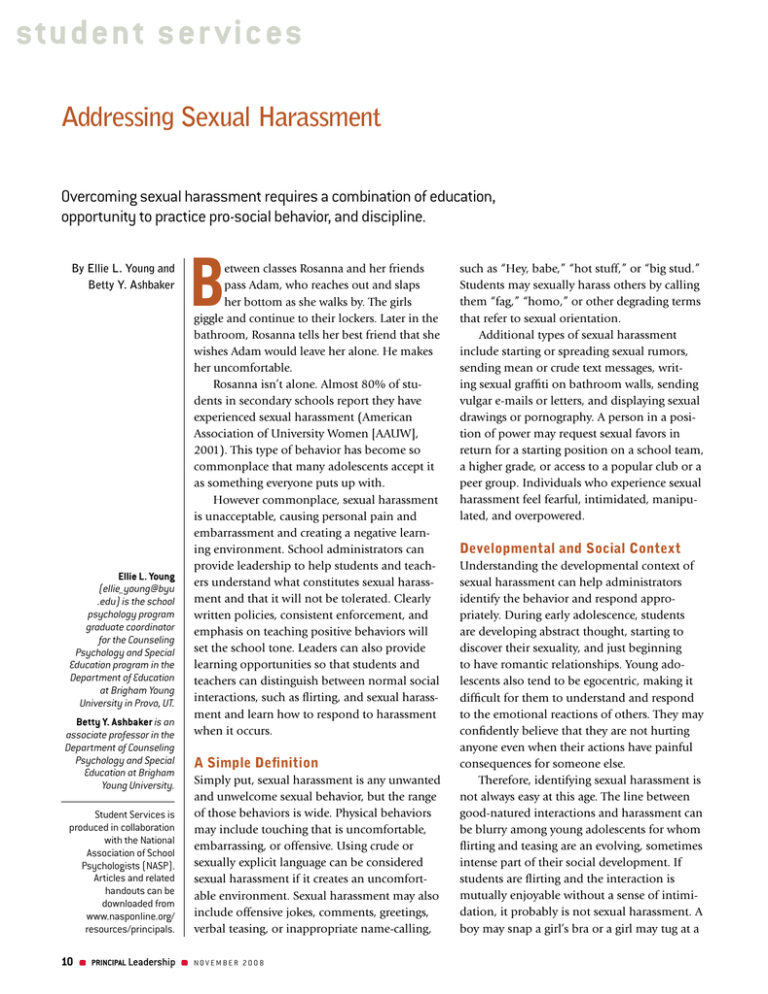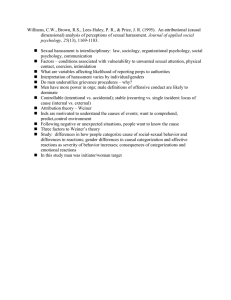
student ser vices
Addressing Sexual Harassment
Overcoming sexual harassment requires a combination of education,
opportunity to practice pro-social behavior, and discipline.
By Ellie L. Young and
Betty Y. Ashbaker
Ellie L. Young
(ellie_young@byu
.edu) is the school
psychology program
graduate coordinator
for the Counseling
Psychology and Special
Education program in the
Department of Education
at Brigham Young
University in Provo, UT.
Betty Y. Ashbaker is an
associate professor in the
Department of Counseling
Psychology and Special
Education at Brigham
Young University.
Student Services is
produced in collaboration
with the National
Association of School
Psychologists (NASP).
Articles and related
handouts can be
downloaded from
www.nasponline.org/
resources/principals.
10
Principal Leadership
B
etween classes Rosanna and her friends
pass Adam, who reaches out and slaps
her bottom as she walks by. The girls
giggle and continue to their lockers. Later in the
bathroom, Rosanna tells her best friend that she
wishes Adam would leave her alone. He makes
her uncomfortable.
Rosanna isn’t alone. Almost 80% of students in secondary schools report they have
experienced sexual harassment (American
Association of University Women [AAUW],
2001). This type of behavior has become so
commonplace that many adolescents accept it
as something everyone puts up with.
However commonplace, sexual harassment
is unacceptable, causing personal pain and
embarrassment and creating a negative learning environment. School administrators can
provide leadership to help students and teachers understand what constitutes sexual harassment and that it will not be tolerated. Clearly
written policies, consistent enforcement, and
emphasis on teaching positive behaviors will
set the school tone. Leaders can also provide
learning opportunities so that students and
teachers can distinguish between normal social
interactions, such as flirting, and sexual harassment and learn how to respond to harassment
when it occurs.
A Simple Definition
Simply put, sexual harassment is any unwanted
and unwelcome sexual behavior, but the range
of those behaviors is wide. Physical behaviors
may include touching that is uncomfortable,
embarrassing, or offensive. Using crude or
sexually explicit language can be considered
sexual harassment if it creates an uncomfortable environment. Sexual harassment may also
include offensive jokes, comments, greetings,
verbal teasing, or inappropriate name-calling,
november 2008
such as “Hey, babe,” “hot stuff,” or “big stud.”
Students may sexually harass others by calling
them “fag,” “homo,” or other degrading terms
that refer to sexual orientation.
Additional types of sexual harassment
include starting or spreading sexual rumors,
sending mean or crude text messages, writing sexual graffiti on bathroom walls, sending
vulgar e‑mails or letters, and displaying sexual
drawings or pornography. A person in a position of power may request sexual favors in
return for a starting position on a school team,
a higher grade, or access to a popular club or a
peer group. Individuals who experience sexual
harassment feel fearful, intimidated, manipulated, and overpowered.
Developmental and Social Context
Understanding the developmental context of
sexual harassment can help administrators
identify the behavior and respond appropriately. During early adolescence, students
are developing abstract thought, starting to
discover their sexuality, and just beginning
to have romantic relationships. Young adolescents also tend to be egocentric, making it
difficult for them to understand and respond
to the emotional reactions of others. They may
confidently believe that they are not hurting
anyone even when their actions have painful
consequences for someone else.
Therefore, identifying sexual harassment is
not always easy at this age. The line between
good-natured interactions and harassment can
be blurry among young adolescents for whom
flirting and teasing are an evolving, sometimes
intense part of their social development. If
students are flirting and the interaction is
mutually enjoyable without a sense of intimidation, it probably is not sexual harassment. A
boy may snap a girl’s bra or a girl may tug at a
boy’s pants with no harm intended because, in
his or her mind, it is simple flirtation. The harassed student may respond in a light-hearted
way, because he or she is either having fun or
trying to avoid embarrassment, despite feeling
uncomfortable or threatened. Sometimes it
can be a little of both. But the perceptions of
the student who is being harassed, not the
harasser, need to weigh most heavily in deciding if harassment has occurred. Even if sexual
harassment is not a motive, if the target finds
the behavior uncomfortable, embarrassing, or
threatening, it requires intervention.
High school students generally have a better developed capacity to understand romantic
relationships, tend to have more mature social
skills, and can think abstractly. They may still
be self-centered and unable to understand the
complexity of sexual behavior, but it is reasonable to expect most older adolescents to be
able to recognize when their actions are inappropriate or hurtful to others. Their harassing
behaviors may be more sophisticated than
those of younger students, and they also may
be more aware of how to keep the behaviors
hidden from adults. All students, regardless of
their age, may be hesitant to report harassment
because they are embarrassed or fear the situation will become public.
The media can be a significant influence
for all age groups. Students are inundated with
images of sexual behavior and, in some cases,
inappropriate bullying or hurtful flirting that
can shape how they interact with the opposite
sex. Such behavioral models can be terribly
confusing to students who are learning to set
personal boundaries, particularly for young
adolescents. Moreover, the media rarely accurately represent the potential harm or resulting
repercussions from harassing or aggressive
sexual behaviors.
Effective Sexual Harassment
Policies
An effective policy to prevent and address
sexual harassment includes the following:
n A clear message that sexual harassment is
unacceptable
n School‑specific examples to assist students in
identifying sexual harassment
n A description of how awareness and skills building for
students will be incorporated into curricula
n Commitment to staff training and their role in creating safe school
environment
n A description of how claims will be investigated
n A statement prohibiting retaliation
n Specific disciplinary consequences for harassment and retaliation
n Opportunities to teach students (both the harasser and the victim)
pro-social replacement behaviors
n A list of resources that is available to both the victim and the perpetra-
tor, such as counseling or outside community resources.
Guidelines for creating an easily understood policy are available online at
www.aauw.org/research/harassmentFreeHallways.cfm.
november 2008
Principal Leadership
11
student ser vices
Resources
Classrooms and Courtrooms: Facing Sexual Harassment in K–12 Schools.
N. Stein. 1999. New York: Teachers College Press.
Checklist for a Comprehensive Approach to Addressing Harassment.
U.S. Department of Education, Office for Civil Rights. 2005. Retrieved
August 1, 2008, from www.ed.gov/about/offices/list/ocr/checklist.html
Flirting or Hurting? A Teachers’ Guide on Student‑to‑Student Sexual
Harassment in Schools (Grades 6–12). N. Stein & L. Sjostrom. 1994.
Washington, DC: National Education Association.
Harassment-Free Hallways: How to Stop Harassment at School. American
Association of University Women. 2002. Retrieved August 1, 2008, from
www.aauw.org/research/harassmentFreeHallways.cfm
Revised Sexual Harassment Policy Guidance: Harassment of Students
by School Employees, Other Students, or Third Parties. U.S. Department
of Education, Office for Civil Rights. 2001. Retrieved August 1, 2008, from
www.ed.gov/about/offices/list/ocr/docs/shguide.pdf
Sexual Harassment: It’s Not Academic. U.S. Department of Education,
­Office for Civil Rights. 2005. Retrieved August 1, 2008, from www.ed.gov/
about/offices/list/ocr/docs/ocrshpam.html
Prevalence and Forms
Most sexual harassment is verbal: sexual comments, name calling, jokes, gestures, or looks.
For both boys and girls, 54% admit that they
have harassed someone in a school setting.
Students report that sexual harassment typically occurs in such places as the cafeteria, hallways, and classrooms, places where adults are
present but do not notice the behaviors and so
do not intervene (AAUW, 2001).
Girls and boys report experiencing sexual
harassment at the same rate but in different
forms. Girls are more likely than boys to be
physically harassed and are also more likely
to be harassed by adults. Boys are more likely
to be verbally harassed. They also may find it
more difficult to report harassment because
they fear that adults may assume that boys
should enjoy the attention of girls or that boys
12
Principal Leadership
november 2008
should stand up for themselves, rather than
report their discomfort to authorities (AAUW,
2001). Students who are exploring their sexual
identity can be particularly vulnerable to
sexual harassment and bullying. Because of
the added complexity of the social-emotional
issues involved at this age, administrators
should be sure that staff members are trained
to support the needs of those students.
Sexual harassment of students by adults is
less common than harassment among students (AAUW, 2001) but is extremely serious,
involving a gross abuse of power and trust.
And occasionally, students sexually harass
adults (AAUW), often targeting support staff
members—such as paraeducators, cafeteria
workers, and janitors—who are perceived
as less powerful. In all cases, school leaders
must ensure that staff members and students
understand appropriate boundaries, what their
rights are, and that violations will be dealt with
immediately and seriously.
A growing area of concern for educators
and parents is cyber–sexual harassment that
occurs through e-mail, instant messaging, text
messaging, Web sites, and cell phones. Sometimes this is intentionally cruel. Other times,
students may not be aware that teasingly photographing a peer in the locker room and then
sending the pictures as a joke can have serious,
long-term (and legal) consequences. (See “Student Services: Cyberbullying” in the September
2008 issue of Principal Leadership.)
Responding to Sexual Harassment
According to Title IX, each school must have a
written, public policy against sexual discrimination, including the behaviors associated
with sexual harassment. The policy should
define sexual harassment, clearly state that it
is inappropriate, and identify a procedure for
investigating complaints. Although schools
typically designate one person who is trained
to investigate claims of sexual harassment, it
is preferable to assign two individuals, a male
and a female, because students may be uncom-
fortable reporting harassment to an adult of
the opposite sex.
Legal problems arise when school personnel are aware of an incident of sexual harassment but do not effectively respond or do not
follow school policy. Ignoring or downplaying reports of sexual harassment has been an
underlying factor in several lawsuits. Students
are more likely to report sexual harassment
when they perceive that school adults are
trustworthy, caring, and will respond in a
supportive manner. The student should be
assured that she or he will be protected from
retaliation.
When students talk about experiencing
sexual harassment, they report feeling upset,
embarrassed, anxious, vulnerable, and unsafe.
Some students report feeling used, unclean, or
dirty. They can feel anxiety; distress; confusion;
and some symptoms of depression, especially
a sense of helplessness. They may avoid places
where the harassment occurred or experience
physical symptoms that keep them out of
school.
Students often have difficulty talking to
adults about sexual harassment. They may
wrongly assume that they are to blame because
of something they said or did. Administrators
and staff members must never imply that the
student is responsible for the harasser’s offensive behavior. Students should not be told, “If
you had told us earlier, we could have stopped
it before it got to this point.” When a student
reports being sexually harassed, it is important
not to downplay their experience or reaction.
Telling the student “just ignore the person and
it will stop” discounts the student’s discomfort,
sending a message to both the student and the
harasser that adults will not make the effort or
do not know how to protect students.
Some students do not report sexual harassment because they fear retaliation. Increasing
supervision is a vital key to decreasing harassing situations; it is also important to create
clear expectations for respectful behavior and
implement consequences when hurtful behav-
ior occurs. The harasser will need opportunities to learn and apply appropriate social skills,
which could include apologizing or seeking
attention appropriately. The response also may
include a schedule change for the harasser; the
student victim should not be inconvenienced
because of the harasser’s behavior. Teaching
the student victim how to respond assertively
and to set and maintain boundaries should
also be part of a comprehensive intervention
plan.
Preventing Sexual Harassment
Legal problems
arise when
school personnel
are aware of an
incident of sexual
harassment but
do not effectively
respond or do not
follow school policy.
Efforts to prevent sexual harassment should
begin with administrative leadership; be
ongoing; involve staff members, students, and
parents; and be consistent with other positive behavior and school safety practices. A
well‑written and accessible school policy developed by members of the school community
november 2008
Principal Leadership
13
student ser vices
Classes covering
civil rights,
diversity, or
tolerance can
include the topic of
sexual harassment
and provide
opportunities to talk
about respectful
behavior.
14
Principal Leadership
must clearly communicate that sexual harassment is unacceptable. The AAUW has posted
guidelines for creating an easily understood
policy on its Web site (www.aauw.org/research/
upload/completeguide.pdf).
Although the policy should emphasize a
protective zero-tolerance approach, it should
not limit how administrators can discipline
students. All inappropriate behavior should be
addressed and stopped immediately, regardless
of its designation. Disciplinary consequences
should take into account the developmental
and social context of the behavior (e.g., whether the students are friends or an imbalance of
power exists between the perpetrator and the
victim), and provide for opportunities to teach
students pro-social replacement behaviors,
such as showing kindness and respect.
Developing a policy alone is not enough.
The policy must be supported by staff members, parents, and students, who should understand their important role in decreasing sexual
harassment as well as in creating supportive
and respectful school environments. All staff
members should receive specific training to
help them identify and respond to sexual
harassment.
Students should have multiple opportunities to understand sexual harassment and other
forms of bullying. Classes covering civil rights,
diversity, or tolerance can include the topic
of sexual harassment and provide opportunities to talk about respectful behavior. Specific
lessons on sexual harassment should provide
concrete examples on such topics as how to
make clear the behavior is unwelcome, the
harmful consequences, and alternative ways to
seek attention.
Although a short video can introduce a
topic, watching a video in isolation is not as effective as a discussion. Secondary students are
just learning how to set personal boundaries,
especially as they move into secondary settings,
and they may need specific, directed instruction about how to do so. It is particularly
important to teach young people how to say,
november 2008
“Stop, I don’t like that” assertively and clearly
so that their peers genuinely understand that
their behavior is unwelcome. Role-playing
during instruction, particularly for younger
adolescents, helps students practice their
emerging skills. Lessons should be reinforced
throughout the year. Parents should be aware
of curricula and classroom discussions and
talk to their children about boundaries and
expectations for respectful, caring behavior.
Of utmost importance is the supervision that
parents can provide, especially surrounding
electronic communication.
Conclusion
Sexual harassment is a sensitive topic. Merely
providing students, parents, and staff members
with information about the school’s sexual
harassment policy is insufficient; schools must
take decisive action. They must provide positive, proactive behavioral supports, ongoing
training, and discussions as part of the daily
school routine, rather than relying solely on
disciplinary consequences for inappropriate
behavior and language. All faculty and staff
members must model appropriate behaviors.
Further, administrators, teachers, students, and
parents must nurture an inclusive, supportive,
and respectful environment in their efforts to
decrease and eliminate sexual harassment. PL
Reference
n American Association of University Women.
(2001). Hostile hallways. Retrieved from www
.aauw.org/research/hostile.cfm
Tell us what you think
about this issue of PL. Your
feedback is vital to making
your magazine a useful tool.





